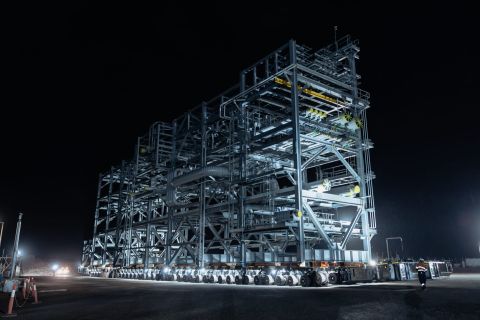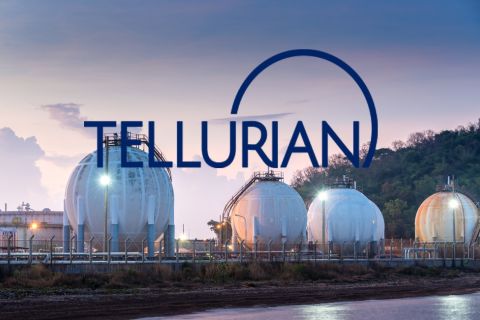
Chesapeake Energy is cutting costs and shaving nonproductive time by opting to self-source sand instead of using third-party suppliers. (Source: Video Arts Studios/Shutterstock.com)
FORT WORTH, Texas—For a company that pumps about 4 million tons of sand per year—enough to fill Oklahoma City’s Chesapeake Arena six times—it’s no wonder why thoughts turned to self-sourcing when free cash flow neutrality and reducing debt were goals.
“We have saved over this last year $100 million by supplying our own sand. That’s massive for us,” Jason Pigott, executive vice president of operations and technical services for Chesapeake Energy Corp., told attendees of Hart Energy’s DUG Sand conference on April 15. Added benefits included reducing nonproductive time (NPT) by 92% in the last few months with no negative impact on production, he said.
The accomplishments didn’t require adding another division to the company’s supply chain group as he originally feared. It came by adding two people with expertise to the organization, forming valuable partnerships and lots of planning. Although the Oklahoma-based company does not have any assets in the Permian Basin, Pigott said the company’s sand story is universal to everyone in the E&P business.
The story was shared as operators continue to focus on costs and efficiency as they try to add value from unconventional oil and gas assets in the U.S. Chesapeake is cutting costs and shaving nonproductive time by opting to self-source sand instead of using third-party suppliers.
With assets in the Powder River Basin, Midcontinent, Marcellus, Haynesville and the Eagle Ford among other spots, the company does not take a one-solution-fits-all approach when it comes to sand sourcing. In the Powder River and Appalachia, for example, northern white sand by rail is self-sourced, while regional sand—also self-sourced—is used in the Midcontinent, South Texas and Brazos Valley. The company uses regional sand in the Haynesville, but it is vendor managed.
For Chesapeake, the number of rigs running is a factor in determining whether to self-source in a basin. In Haynesville, for example, the company runs one to two rigs, compared to four each in South Texas and Brazos Valley.
“If you’ve got one rig, it’s [self-sourcing] probably not going to be for you. … You have to have mass to make it work,” he said.
A hybrid strategy is something companies should think about if they are considering self-sourcing, taking into account the location of sand mines, which facilities can handle spikes in demand and trucking expenses, according to Pigott.
Another big consideration is an obvious one—reservoir properties along with the potential impact on EURs and completion designs.
Chesapeake began testing regional sand in 2013, looking at the supply of northern white, Pigott said, adding “it never quite worked out” as market conditions prevented a full transition. But the opportunity surfaced again five years later in 2017 as regional sand mines came on stream, prompting Chesapeake to carry out regional sand testing in various assets to determine the impact of regional sand use on production in some of its assets.
“We felt comfortable that regional sand in an area like the Eagle Ford was not going to be detrimental to our production. So that caused us to make that shift,” Pigott said.
By mid-2018, Chesapeake was decoupling its frac services and lining up partners for logistics and sand. The company started its direct-sourcing transition in fourth-quarter 2018, pumping regional sand and managing final mile transport, he said.
The change has resulted in 50% cost savings vs. traditional northern white sand and a 92% drop in sand-related NPT, according to Pigott, calling it a game changer for the company.
“As we’ve gone to this micro supply chain, it’s a lot of clarity,” Pigott said. There have been times in the past when a vendor would say it was waiting on sand while down fixing pumps, he said, noting you couldn’t really tell whether time was needed to fix pumps or for sand to arrive. “Now they are no longer waiting on sand. … We have clarity into what’s really going on.”
It also helps that Chesapeake acquired the Burleson Sand Mine as part of its purchase of WildHorse Resource Development Corp. that closed in February.
“We are not only supplying sand; we are operating a mine,” Pigott said. “That mine is up and running today. It supplies about half our sand.”
Meanwhile, other vendors in the region supply the rest. “Those things are really moving the costs down,” he said.
Session moderator Richard Mason, chief technical director for Hart Energy, pointed out evolution taking place within the industry. “We’ve gone from an industry where we have specialized E&Ps, specialized service companies. Are we going back to a vertically integrated industry?” he asked.
For Chesapeake, “the big thing is clarity,” Pigott responded. “Everybody was taking a slice of the profit and getting margin along the way. When we started to decouple, we knew exactly what sand costs. … Are we going to decouple everything? No, but when you’re pumping 8 billion pounds of sand, that’s a big ticket item that you may want more clarity into.”
Velda Addison can be reached at vaddison@hartenergy.com.
Recommended Reading
Gunvor Group Inks Purchase Agreement with Texas LNG Brownsville
2024-03-19 - The agreement with Texas LNG Brownsville calls for a 20-year free on-board sale and purchase agreement of 0.5 million tonnes per annum of LNG for a Gunvor Group subsidiary.
Texas LNG Export Plant Signs Additional Offtake Deal With EQT
2024-04-23 - Glenfarne Group LLC's proposed Texas LNG export plant in Brownsville has signed an additional tolling agreement with EQT Corp. to provide natural gas liquefaction services of an additional 1.5 mtpa over 20 years.
Woodside’s Pluto Train 2 Nears 2026 Start Up with Modules Delivery
2024-02-21 - First 3 of 51 modules have arrived on site in Western Australia for the onshore LNG project that will receive gas from the offshore Scarborough project.
FERC Approves Extension of Tellurian LNG Project
2024-02-19 - Completion deadline of Tellurian’s Driftwood project was moved to 2029 and phase 1 could come online in 2027.
NextDecade Targets Second Half of 2024 for Phase 2 FID at Rio Grande LNG
2024-03-13 - NextDecade updated its progress on Phase 1 of the Rio Grande LNG facility and said it is targeting a final investment decision on two additional trains in the second half of 2024.





